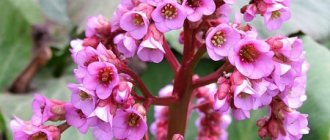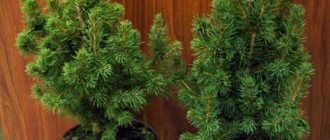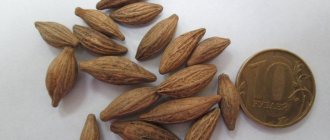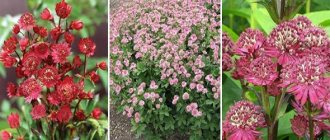Category: Succulents, Care Published 10/17/2018 · Comments: · Reading time: 6 min · Views: 4,844
Ball-shaped herbaceous bushes in the flowerbed, densely strewn with bright yellow flowers, fill the garden with special bursts of sunshine. Flower growers love Euphorbia multiflora for its ease of care, ease of propagation and ability to lift the spirits with elegant flowering.
The plant lives in many European countries - Austria, the Netherlands, Germany, Bulgaria, Greece, including the island of Crete, Italy, Romania, Moldova, Ukraine. On the Asian continent it is found only near the northwestern edge of Turkey, and in Africa - only in the north of Libya.
The herbaceous shrub prefers to grow on rocky screes of calcareous slopes of small hills; it is found on the edges of deciduous forests, lost in thickets of bushes, along the coast of small rivers and streams. Known in cultivation since 1805.
Varieties of garden milkweed
There are a wide variety of different types of garden euphorbia: with bud scales, spines, flower buds or hard fleshy sprouts. They may have a smooth, faceted or ribbed stem and leaf structure. The most popular and beloved by gardeners are euphorbias:
- Bordered.
- Belozhilkovy.
- Cypress.
- Trihedral.
- Obergonia.
- Tirukalli.
- Comb.
- Mile, palace.
But perhaps the most interesting will be Euphorbia multiflorum - in demand among landscape designers and flower growers. The plant is a bush up to 70 cm in size, large spherical in shape, capable of growing in diameter up to 140 cm. The leaves are small, oval-shaped, about 7 cm wide. It is distinguished by long-term flowering, combining shades and tints of yellow, green, orange and creating an amazingly beautiful decorative flash effect.
Euphorbia Obergonia de Negri is a small spherical plant about 12 cm in diameter. It has a gray or dark green fleshy stem covered with small triangular leaves 1 cm long and 2.5 cm wide. Their tops are framed by areoles with 3 or 4 light yellow spines. Blooms with white and pink flowers.
Crested spurge is a comb-shaped evergreen euphorbia. Blooms white or pink from the first year. Its stem is a rich dark green color, pentagonal in shape, without branches. Tufted arrangement of large elongated leaves 13 cm long and 5 cm wide with reddish petioles about 1.5 cm long. Plant height no more than 1 m 20 cm.
Euphorbia crassifolia - reaches more than 65 cm in height. An evergreen shrub with red-purple foliage. The leaves are elongated, up to 20 cm in length. Quite a spectacular plant, especially at the beginning of summer, when it begins to bloom.

Myrtle-leaved spurge is a low shrubby flora up to 25 centimeters with creeping stems. Densely dotted with small, 1.5 to 3 cm long, double diamond-shaped leaves, gray-blue in color. It blooms twice a year - in April and July with small (up to 1.5 cm in diameter) pale yellow flowers.
Euphorbia white-veined - its stem is dense and thin and has 5 ribs with gradual thickening towards the top. It can reach two meters in height. The leaves are dark yellow with white veins, attached to the trunk with thin petioles and more than 25 cm long. This species does not have beautiful flowers - after flowering, a dense capsule with seeds inside remains.
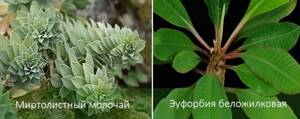
There are quite a lot of varieties and varieties of garden milkweed, and despite all their splendor, without appropriate proper care, the beauty of the plant fades and loses its original grandeur and shape.

Caring for garden milkweed
Garden spurge is tolerant of dry summer periods and requires moderate watering only in the event of a rainless, hot summer. However, excessive moisture is contraindicated for it; it negatively affects the oxygen respiration of the root system - it rots and dies. In this case, the plant cannot be saved.
Euphorbia should be fertilized several times a season with complex mineral fertilizers. The greatest need for feeding occurs in milkweed during the period of active vegetative growth. At this time, the recommended frequency of fertilizing is once every fourteen days. As an organic fertilizer, you can use rotted compost or wood ash by mulching the moistened soil.
You should avoid mineral fertilizers with a large amount of nitrogenous substances - the plants will stop blooming, become vulnerable to fungal diseases and subsequently will not tolerate the cold season well.
Autumn care for garden spurge involves mulching it with peat or sawdust.
How to care for milkweed at home and in the open ground
Euphorbia, the species of which are so diverse and not similar to each other, is very unpretentious in care. This plant is suitable for a busy gardener who does not have time for frequent watering, fertilizing and pruning the plant.
Soil for planting
The best soil composition for planting milkweed is a mixture of soil, peat and sand in equal proportions. Some gardeners advise adding crushed coal when preparing a flower bed.
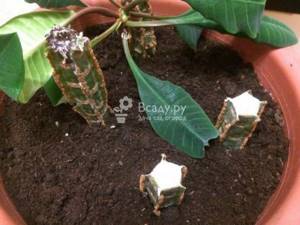
Euphorbia loves mixed soil type
Watering mode
Like all succulents, milkweed is afraid of excess moisture. That is why it needs to be watered very moderately, moistening only the top layer of soil.
When overwatered, the plant begins to turn yellow and shed its leaves. In autumn and winter, watering should be stopped altogether. For indoor plants, it is enough to spray the soil with a spray bottle once every 1-2 weeks, and water only if the soil begins to crack.
Lighting
Euphorbia loves bright light (the exception is bordered euphorbia). When choosing a place for a flower bed in the garden, give preference to an open, sunny area. Indoor spurge will grow and develop best when cared for at home on a windowsill on the south or southwest side.
Feeding milkweed
To feed indoor plants, you can use ready-made complex fertilizers for bromeliads and orchids. Ball-shaped species of milkweed do not like nitrogen-containing fertilizers - the skin of their stems and leaves may crack.
During flowering, garden species of milkweed can be fertilized with traditional mineral compounds for flowering plants (for example, Fertika-lux fertilizer). Experienced gardeners recommend halving the fertilizer consumption when feeding euphorbias, or increasing the amount of water when diluting the concentrate.
Milkweed propagation
Reproduction of garden euphorbia occurs in three possible ways.
Seeds
Prepare a mixture of sand and soil in a pot, moisten it and plant the seed in this soil to a depth of 1.5 cm. To improve germination, keep the temperature within +18...+19°C. Picking should be done when the first shoots appear at 1 cm.
Dividing the bush
Bush propagation is possible if milkweed is already growing in the garden. At the moment soil formation begins (April-May), carefully dig up the plant and divide it into small bushes. Make sure that when dividing there are at least two or three buds on each one. Then plant them in pre-prepared places in the garden.
Cuttings
Propagation and planting of milkweed by cuttings should be carried out in early June. Select healthy young shoots and cut them diagonally with a sharp knife. Wash off the milky juice that appears with warm boiled water, and sprinkle fresh sections (both on the cuttings and on the mother branch) with finely ground activated carbon powder. Leave the prepared cuttings for several days in a warm place to dry, and then plant them for further rooting.

Planting a plant
Literally all types of milkweed are easy to care for, so even an inexperienced gardener will not have any problems planting and caring for them.
Choosing a site for planting and preparing the soil
Euphorbia prefers sun-exposed or slightly shaded areas with loose, well-drained soil. The exception is the bordered euphorbia, which prefers shady places, since in the sun its foliage loses its decorative effect. Euphorbia cannot grow in wet and acidic soil, so choose areas that are as dry as possible and lime the soil.
[adsp-pro-5]
The composition of the soil for planting is as follows:
- garden soil - 1 part;
- peat soil – 1 part;
- sand – 1 part;
- brick chips and wood ash - 1 cup per plant.
When planting tall species, it is recommended to add half a part of rotted humus or compost to the substrate.
Time and features of landing
Euphorbia can be planted outdoors in spring or early fall. Spring planting is preferable, since the bush adapts well over the summer and can survive the winter without problems.
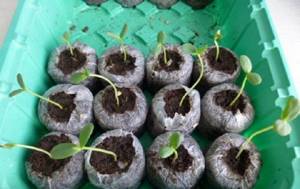
Euphorbia seedlings begin to be planted in open ground in the spring.
For planting, it is necessary to prepare a hole with a diameter and depth of 50 centimeters and a depth of about 20 centimeters. A drainage with a height of at least 10 centimeters must be placed at the bottom. A little soil is poured onto the drainage layer, and then the seedling is placed. Euphorbia planted in a hole is watered abundantly, and then the surface is mulched.
Diseases and pests
Euphorbia is quite resistant to pathogens and various insect pests. Her caustic milky juice helps her well in this. However, if you do not care for the plant correctly, you can cause irreparable harm to it.
At low temperatures and excess soil moisture, garden spurge is affected by fungal diseases:
- Powdery mildew.
- Spotting.
- Root rot.
- Fusarium.
Fungicides or cutting out and disposing of affected plants can help in treatment.
Insufficient lighting can lead to impaired photosynthesis and the dropping of leaves and flowers. In this case, the spurge is dug up and transplanted to a lighted area of the garden.
Pests that attack euphorbia:
- Spider mite.
- Shield.
- Aphid.
- Nematodes.
The plant usually acquires such pests when the planting material is obviously of poor quality or the planting is dense. You can get rid of the problem with the help of insecticides and thinning.
Mr. Summer Resident Explains: Combining Milkweed with Other Plants
Caring for milkweed is simple: moderate watering as needed, weeding and fertilizing. If it grows excessively, it loses its shape - a supporting wire frame or correct placement in the landscape composition will help here.
Euphorbia loves warm sunny places with little shade. In nature, it grows on rocky slopes of mountains and cliffs. A good place in the composition for milkweed would be alpine hills or a landscape that imitates a desert oasis. The beauty of euphorbia stands out most clearly among monochromatic flowers, plants, stone compositions or rockeries. Individual specimens, such as multifloral euphorbia, look spectacular when planted alone in a flower bed or in a mixborder - a limited growing area.
In the vicinity of milkweed, thuja, low-growing juniper, antennaria, and woodweed are planted. It is good next to irises, bells, forget-me-nots, tulips and climbing roses.
When caring for and replanting milkweed, you should wear gloves so that accidentally ingested milky sap from the plant does not provoke an allergic reaction.
Euphorbia - harm and benefits of the plant for the body
Euphorbia has long been known for its medicinal properties. The juice of this plant is credited with a variety of qualities: from destruction and protection against the formation of cancer cells, to neutralizing snake bites.
Since ancient times, in Russia, milkweed infusion has been used to get rid of warts and calluses, and also to lighten freckles on the face. The juice of this plant contains mineral salts, rubber, alkaloids, as well as many substances beneficial to the body.
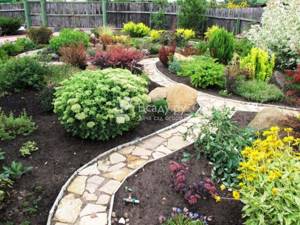
Euphorbia in garden landscape design
Unfortunately, there are no recipes left tested by healers. It is strictly not recommended to use milkweed juice without recommendations - it is very poisonous and can cause burns, itching and irritation of the skin.
The juice should not be allowed to get into the eyes or mucous membranes, and therefore it is better for children and animals not to come into contact with milkweed. When transplanting and other procedures, you should wear protective rubberized gloves.
